Endemic Pathogens Are Making You Crazy And Then Killing You: Toxoplasmosis Spotlight

In February 2022, Jim Keller organized a scientific anarchism event in Woodside, California. Scientific anarchism, a term borrowed from the controversial philosopher of science Paul Feyerabend, concerns the way science is performed in the laboratory and the way that ideas are generated, refuted, and incorporated into the accepted scientific body of knowledge.
At the conference, I gave a talk about the parasite Toxoplasma Gondii for the first time. It’s a single-celled parasite that can cause debilitating diseases, including neurological and psychiatric problems, yet most of us are unaware that we carry it. According to the US Centers for Disease Control and Prevention, it is one of the five most neglected parasitic infections in the United States. I opened my talk with 'I'm here to ruin your day!' I again hope anybody who reads this piece is left unsettled.
Firstly, a disclaimer. I am not a biologist. I am an enthusiastic researcher who enjoys looking for assumption errors in different fields. While I have consulted a breadth of experts on these topics if you spot an error while reading this, I offer a $25 reward for introducing me to data that we both agree shows that a statement in this essay is mistaken. However, I do think a large chunk of literature on these topics has a strong fallibility bias for historical reasons, which I will talk about below.
_____
Paradigm Shifts and Accidental Discoveries in Science
Before I discuss novel ways to study and develop treatments for Toxoplasma Gondii, let’s zoom out and talk about the scientific process in more general terms. In science, the process is just as important as the discoveries. Improving our scientific processes will speed up our rate of discovery. Feyerabend claims contemporary research has over-indexed on processes such as the scientific method, and this rigidness has restrained innovation. The crux of his book Against Method is that scientific paradigm shifts stem from epistemological anarchism. Epistemology refers to the formulation of beliefs. To any Thomas Kuhn fans, this anarchy is necessary to achieve Kuhn’s Stage 4 phase of science, the ‘revolutionary phase’ in which new paradigms are created. In recent decades, we have placed too much importance on science being consistent while forgetting that paradigm shifts often come from those who refute mainstream assumptions. In other words, the geniuses who generated scientific paradigm shifts were anarchists to their contemporaries. Or success came when they made mistakes, take vaccines, for example:
The modern medical sense of immunity, meaning "exempt from a disease", dates back to 1879, when Louis Pasteur produced the first laboratory-developed vaccine: a vaccine for chicken cholera. Pasteur happened upon his inoculation breakthrough by accident. His lab was studying fowl cholera by injecting chickens with live bacteria and recording the fatal progression of the illness. Pasteur had instructed an assistant to inject the chickens with a fresh culture of the bacteria before they both went on vacation. The assistant, however, forgot to inject the chickens before he left. When the assistant returned a month later, he finally injected the chickens with the bacteria, which was now a month old. Unlike their typical experiments with the bacteria, the chickens only showed mild signs of the disease this time and survived. When they were healthy again, Pasteur injected them with fresh bacteria. The chickens did not become ill. This is how we got vaccines - by accident.
A Brief Overview of Infectious Disease
Despite how popular immunology has become as a field in recent times, it's important to clarify some terminology.
A pathogen is an organism that causes disease; of which there are five main types: viruses, bacteria, fungi, worms and protozoa. An epidemic refers to a disease spread across a local region: for example, an isolated flu outbreak in a city. We should all know what a pandemic is by now. It is an epidemic disease that has spread over a much larger area: for example, a country, a continent or the whole world. The next level up of disease spread is classified as endemic, and endemic diseases are the focus of this essay. An endemic disease has a level of permanence, but the term does not confine itself to a locality. Herpes simplex viruses are globally endemic. ~ 3.7billion people for HSV-1 alone and there are seven other types of Herpes viruses! A disease such as Malaria is endemic to specific regions.
For many people, infections like Herpes simplex 1 remain asymptomatic and do not produce symptoms like the cold sores they are usually associated with. However, our cultural mistake is that we think that the occasional cold sore is the main fear factor for carrying latent (dormant) infections like HSV-1. In reality, the dangers of living with endemic diseases like HSV seem to be tied to several later on-set neurodegenerative diseases and even chronic illnesses such as cancer.
Let’s also define communicable diseases and non-communicable diseases. Communicable diseases are what we know as infectious diseases. They spread from one person to another in many ways: contact with bodily fluids, breathing in an airborne virus, or being bitten by an insect. Noncommunicable diseases aren’t spread from person to person (or from another organism to a person, or vice versa). They are chronic conditions that don’t seemingly stem from infection: conditions like heart disease, cancer, and diabetes, for which a complete cure is harder or rare to achieve.
However, communicable infectious disease exposure may be causing noncommunicable chronic conditions much more than we think. Plenty of research demonstrates the link between infectious diseases and later health issues. For one example, new research solidifies the link between the Epstein-Barr Virus (the virus that causes Mono) and the chronic, debilitating neurological condition known as Multiple Sclerosis. Yet, the average person, while often being a carrier, is not aware of these risks.
When we think of pathogens, we think of immediate physical symptoms—in other words, the acute phase of illness. A growing number of biologists, especially evolutionary biologist Paul W. Ewald, believe we need to change how we think of these diseases and their role in chronic illness. Ewald has been at the forefront of this conversation for the last few decades despite the biomedical industry not taking his claims seriously enough. The EBV to MS paper must have been a small victory.
As we’ve always known, but recently brought more into the spotlight with SARS-CoV-2, the infectious virus that causes COVID-19, infections can be asymptomatic (without symptoms). They can also be latent (dormant), as with the Herpes virus, which can reside in the body for years before it flares up in a myriad of different ways. Latent pathogens, once they infect you, are with you for life.
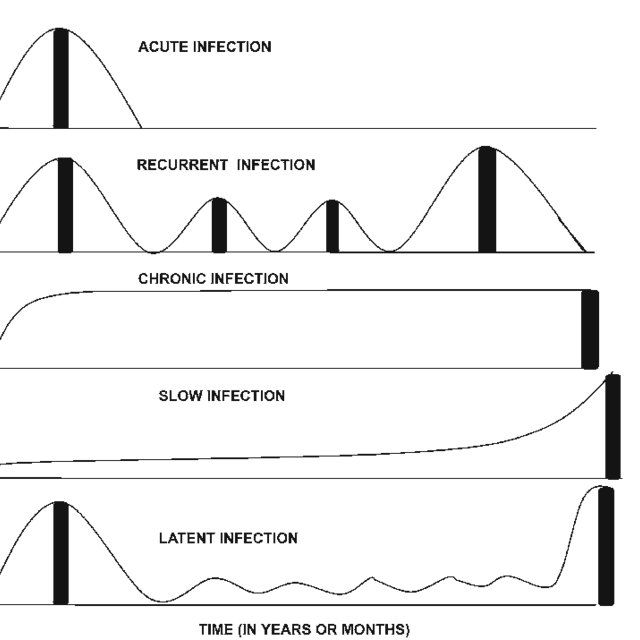
What’s more, you have been exposed to and carry probably several, if not even dozens, of latent diseases. Maybe you had glandular fever as a kid. If so, then that Epstein-Barr virus has never left your body. Probably, at least one of the Herpes viruses is hanging out in your nerve ganglia. You may have Toxoplasma gondii in your brain, which can rob you of your agency and influence your risk tolerance and behaviour. Have fertility issues? Maybe it’s from Trichomoniasis, a sexually transmitted parasite that millions of people carry and that seemingly no one has ever heard of. It is estimated that every year, 1.1 million Americans contract Trich, but hardly anyone knows because 70% of its victims show no symptoms. Trich is linked to infertility in both men and women, though couples with fertility issues aren't always tested for it. Endemic diseases are all around us – and inside us – some of which can lie dormant in our bodies for years. I list several of them and their terrifying potential chronic illness ties later on in this essay.
In the second half of the twentieth century, the medical industry championed themselves around the statement “It is time to close the book on infectious diseases, and declare the war against pestilence won.” The quote is often credited to William H. Stewart, who was Surgeon General under Presidents Johnson and Nixon. Still, after looking further into the quote, we have to spare Stewart from this blooper because it’s unclear that he ever said it. The famous quote seems to be some urban legend that swept science away as dogma. Either way, believing that we have conquered infectious disease has been a dangerous assumption and has skewed decades of biomedical research and cost millions of lives.
Paul W. Ewald in his great book Plague Time puts forward that another reason for the slowing down of research in infectious diseases was scientists relying too heavily on guidelines for identifying infectious causation set forth by Robert Koch in 1880. These postulates ultimately proved not to be true in all cases. Koch did not make this error - he specifically cautioned against using his guidelines as the only basis for ascribing infectious causation. Despite this, many experts assumed and postulated that infection causation could only be accepted when all these guidelines were met. Even if important evidence of infectious causation is available, research has often been dismissed if Koch’s postulates have not all been satisfied. The problem is that experts embraced historical postulates as dogmatic truths, which had major consequences for 20th-century research. This highlights Feyerabend’s point: we often need epistemological anarchy to break the reliance on dogmatic truths. In some cases, it is the only way forward.
Thinking Outside The Box On Infectious Disease
One idea largely anarchic to the current paradigm is that endemic pathogens cause issues as broad as cancer and schizophrenia. Oddly enough, the hypothesis that viral pathogens are neurodegenerative is increasingly grounded in evidence, yet, as a society, we’re still stuck to our idea that lifestyle correlations are entirely to blame. And yes, sure, while smoking may correlate with cancer, several herpes viruses, which two-thirds of us carry, induce tumors in animal species. Wellness fanatics flinch at people smoking but have little to no insight into the herpes virus permanently lodged in their brain cells.
Due in part to how narrow and myopic biomedical research has become, the last fifty years of research seem to have massively underestimated the harm caused by endemic infectious diseases. We think of infectious diseases like we think of video game bosses: external agents that get thrown into our global gameplay for us to defeat. COVID-19 was a great example of this. How much money, time and global effort did we put into preventing the viral spread of a new pathogen? The irony is, the pathogens that potentially will hospitalize and kill us are already inside us. Personally, I am far more scared of Epstein-Barr Virus than COVID-19, and I found it annoying to be lectured on pathogens from a government that seemed to have no issue with the endemicity of HSV and Epstein-Barr in our society. That said, it’s possible that, decades later, COVID-19 is also associated with long-term effects stemming from endemicity, which has also been my greatest fear for it. Who knows?
The point is that despite mounting evidence, we as a society don’t consider the role infectious diseases can play in other types of chronic diseases.
It’s tough to determine whether a pathogen plays a causal role in a given chronic disease. Maybe that’s why contemporary biomedical research doesn’t go after it with the same gumption it does for other causes. Firstly, the timing delay between exposure to an infectious pathogen and the appearance of a chronic disease could be decades. This creates a study timing problem, which can only be solved if you have a large enough population sample to correlate infectious disease antibodies and noncommunicable disease symptoms. But still, that’s not enough. Different genetic variants of infectious pathogens manifest in people differently. Furthermore, genes may play a role in the onset of a chronic illness. For an example, check out this review linking Herpes simplex 1 in the diagnosis of Alzheimer’s disease patients with the gene APOE-4, which is associated with Alzheimer’s disease.
It’s largely unethical to infect humans with pathogens to study them, and how these pathogens manifest in laboratory animals may also be different. On top of that, we would expect pathogens to cause diseases indirectly, such as via autoimmune processes induced by the pathogen. This seems to be the case for several chronic illnesses, and it makes it hard to track. Biology is complex. Unfortunately, we reward researchers for finding one piece of the correlation puzzle and then rely too heavily on it, ignoring the forest for the trees.
Our descendants will probably laugh at how passively we accepted endemic pathogens and instead blamed genetics and environment for chronic illness. As Paul W. Ewald humbly suggests, the truth will probably not be binary. Most likely, the etiology of our contemporary chronic ailments will include both infectious and noninfectious causes. Genes that correlate with increased susceptibility to certain cancers may be genes that increase our susceptibility to the harm of the pathogens that lead to cancers.
Let’s go back to the parasite Toxoplasmosis Gondii, which causes Toxoplasmosis. This parasite is linked to schizophrenia and other psychiatric disorders. An individual might be exposed to Toxoplasmosis from cat faeces or by eating meat from infected cattle. However, one could also be born infected with Toxoplasmosis from either parent. Therefore, Toxoplasmosis-induced schizophrenia could seemingly have varying levels of genetic, environmental, and infectious causation. To demonstrate how broad the etiology of this disease could be, here is a study measuring Toxoplasmosis seropositivity in dry-cured ham.
It is a byproduct of our current failures in scientific inquiry that we chase and reward the fallible idea of one camp of causation for illness. Increase the epistemological anarchy in science!
Tying Infectious Diseases with Chronic Illnesses and Psychiatric Disorders
The link between Alzheimer’s disease and infectious disease is arguably the most well-known connection between communicable and noncommunicable disease. Contagion seems likely; after all, neurosurgeons and the spouses of neurodegenerative disease sufferers are ~2x more likely also to develop the same disease. Alzheimer’s disease is associated with the bacteria gingivalis, which is the keystone pathogen in chronic periodontitis, as well as chlamydia pneumoniae (the kind that causes respiratory infections, not the sexually transmitted variant). Treating helicobater pylori positive Alzheimer’s patients with a triple eradication regimen (omeprazole, clarithromycin and amoxicillin), showed increased cognitive and functional status in Alzheimer’s patients after two years. Aggressive antiviral treatment reduced the relative risk by 10x (!). Toxoplasmosis, the later focus of this essay, is also linked to Alzheimer’s.
People who have Alzheimer’s disease typically have plaques of sticky amyloid proteins in their brains, although it remains unclear whether these are a cause or a consequence of the condition. In several studies, amyloid proteins demonstrated transmissibility during brain surgery, potentially infecting new patients via instruments previously used for surgeries on people with Alzheimer’s disease. Last year, questions were raised over whether amyloids might also spread through blood transfusions.
Prions are considered a subclass of amyloids. They are yucky misfolded versions of a protein that can spread like an infection by forcing normal copies of that protein into the same self-propagating, misfolded shape. The quantity of prions in the brain of a patient who died of Alzheimer's at 40 were on average 32 times higher than in a patient who died at 90. Studies have shown that these proteins resist boiling, drying and exposure to formaldehyde. As a result, there is research suggesting that we may be picking up Alzheimer's related pathogens from our trips to the dentist. Normal disinfection just doesn't suffice.
Down in the gut, here, here and here you will find researchers pleading for the broader scientific community to take the role of the protozoal parasite Dientamoeba fragilis more seriously. While it is estimated that 80% of both adults and children have parasites in their gut, for some reason Doctors rarely test patients for them. If you suffer from occasional stomach upset and developed a dairy intolerance later in life, educate yourself on the parasite Giardia. This parasite changes how you metabolize milk sugars and can last for years after infection. For those who suffer from recurrent gastric distress, a doctor may diagnose 'irritable bowel syndrome', which is nothing more than a name for a collection of symptoms. It's worth requesting a test for parasitic infection.
Do you suffer from anxiety? Maybe it comes from a previous exposure to cytomegalovirus. Mostly asymptomatic, cytomegalovirus is a beta-herpes virus which once it has infected you, again stays for life. Infection is associated with increased serum concentrations of cytokines (especially TNFalpha and IL-6) which are also related to mood and wellbeing. Individuals with higher CMV-specific antibody loads were more likely to be depressed, anxious, and suffer more overall psychological morbidity.
Have attachment anxiety issues in relationships? In this study, individuals with attachment anxiety issues had higher levels of antibodies to Epstein-Barr. Another study of college students showed those with EBV antibodies had more defensiveness and anxiety overall. EBV exposure even seems to correlate with how emotionally repressed you are are as a writer. If you've never had EBV, perhaps your anxiety and depression comes from exposure to Helicobacter Pylori, or Toxoplasmosis. There is a strong correlation between gastrointestinal issues and psychiatric disorders and yet psychiatrists rarely work with gastroenterologists to chase the root of the problem.
Have a child with autism in the family? Perhaps they got it from their mother's immune response to a pathogen during pregnancy. Women with high levels of antibodies to Herpes simplex 2 midway through their pregnancies were twice as likely to have a child later diagnosed with autism. A 2013 study found that women who had flu while they were pregnant were also twice as likely to have a child later diagnosed with autism. According to this study of more than 95,000 women, pregnant women who had a fever lasting a week or longer — perhaps caused by influenza or another pathogen — were three times as likely to have an autistic child. The link is strongest in the second trimester, when a single fever is associated with a 40 percent increase in autism risk. Three or more fevers after the first trimester triples the risk of having a child with autism and yet, we rarely hear about it. Inflammatory chemicals such as cytokines are likely crossing the placenta and affecting the developing brain of the fetus, causing birth defects, chronic illnesses and delayed psychiatric issues.
Experience manic episodes that are classified as a Bipolar disorder? Maybe you got it from a Borna virus exposure. This relatively overlooked disease, also amusingly known as sad horse disease, is an infectious neurological syndrome of warm-blooded animals. Borna disease research came largely to a halt because most human studies do not focus on examining brain tissue (as samples are rarely available), but rather, blood samples, where viral loads are much lower. Luckily, research is beginning to kick back off again.
Or maybe your bipolar symptoms came again from Epstein-Barr Virus. EBV can facilitate an autoimmune attack on the brain’s glutamate receptors and could be causing psychiatric issues and manic episodes. EBV seems really bad. As mentioned earlier, a highly-praised longitudinal study tying EBV exposure to Multiple Sclerosis came out and perhaps this paper holds clues to the mechanism of causation. We know of several cancers tied to Epstein-Barr Virus, of which more than 200,000 people are diagnosed with per year, and we might expect there to be many more. In early 2022, Moderna began clinical trials for an Epstein-Barr vaccine, something which, if achieved (in my opinion) will have a much larger global impact on health than vaccines for Covid-19. We can’t even fathom the QALYs (Quality Adjusted Life Years, a measure of healthy years of life) lost to Epstein-Barr Virus globally.
Other viruses also have links to neuropsychiatric and neurological conditions. A large study found a central nervous system infection as a child (particularly with Coxsackievirus B5) increases the risk of developing schizophrenia as an adult by nearly five-fold. Coxsackie B infections have been reported to account for nearly a quarter of all enterovirus infections, of which there are about 10 million per year in the US. Nearly half of all reported cases of Coxsackie B infections occur before the age of five. These infections are also linked to later strokes.
Just this week, the news reported that 94 students from a New Jersey high school developed the same type of aggressive brain tumor. Glioblastoma multiforme is a fast-growing brain tumor that invades the nearby brain tissue. The general consensus is that Glioblastoma is the result of a genetic disorder, but this outbreak suggests environmental or pathogenic exposure. After all, by regular measures, ~7 per 100,000 people are expected to develop the disease per year with an average age of 64 years old at diagnosis. However, the news fails to mention that Glioblastoma has been associated with the viruses SV40 (which is occasionally a vaccine contaminant from Simian research), Herpes Virus 6 and cytomegalovirus. Ironically, viruses could be the cause and also the cure. Recently, a genetically modified version of the Herpes Virus was able to increase the lifespan of Glioblastoma sufferers in clinical trials, research which we have to wonder if those New Jersey doctors even knew about.
Contemporary society champions neuro-diversity and makes it taboo to consider that our psychological issues could have a biological causation. Telling someone that their mental health issues could come from pathogen exposure demeans their experience in individualistic societies. Anecdotally, I know this firsthand from the amount of push back I get from suggesting highly depressed or anxious people try a blood or stool test. We need to change this mentality because people are suffering unnecessarily. Again, how many people are wasting their money on therapies focusing on the ‘mind’ and not on treating their hijacked biology?
As a global community, we have disregarded these repeated links between infectious disease and chronic disease, especially psychiatric. Given the advent of new vaccine technologies, perhaps the time is ripe to focus more on this connection to develop vaccines that can prevent chronic diseases for which there are no cures and which, for decades, the scientific community has blamed on genetics and lifestyle components.
Spotlight Pathogen: Toxoplasmosis Gondii
For the remainder of this essay, I will focus on one specific pathogen - the protozoan parasite Toxoplasma Gondii that causes Toxoplasmosis. A large percentage of people have barely heard of it, let alone fathom the damage it could potentially cause. If you’ve heard of it, it is usually because pregnant women are told to avoid scooping cat litter as cat faeces can infect future mothers, who then pass it on to their babies. In fact, this risk is massively overblown. The prevalence of Toxoplasma oocyst shedding in cats is very low (0-1%), even though 15-40% of cats have been infected with Toxoplasma at some point. This means very few cats at any one time are able to pass their infection directly on to people.
The real risk comes from Toxoplasmosis being endemic in cattle. The numbers are crazy! As much as two-thirds of pigs and a third of dairy cows tested seropositive for Toxoplasmosis, though the numbers differ across different regions. You're picking Toxoplasmosis up from the meat you eat and most likely not from directly handling your favourite feline friend. It's a shame that the CDC puts so much pressure on expecting mothers rather than address the fact that Toxoplasmosis is so widespread in cattle. In 2020, a fascinating paper demonstrated that Toxoplasmosis has an epigenetic signature, meaning the descendants of Toxoplasmosis carriers can still have affected brains. We can’t escape it, which is perhaps one of the reasons why big pharma isn’t incentivized to go after it.
Toxoplasma gondii is a parasitic alveolate of the same phylum (classification) as malaria in a group called Apicomplexa. Toxoplasma Gondii Toxoplasma looks gross like this:
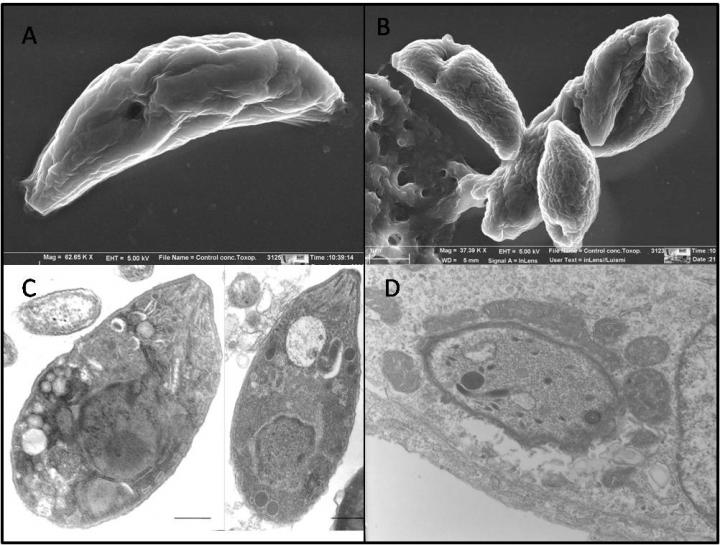
It is thought that potentially up to two-thirds of people carry it. However, it is more heavily prevalent in the West than the East, especially in countries with a culture for consuming undercooked meat, e.g. France with their beloved steak tartare. Cats are the definitive (originating) hosts for Toxoplasmosis, and they pass it to others via their faeces, which, if ingested by scavenging or grazing animals such as rodents, pigs, and cattle, can then harbour the parasite in their brain and other body tissues.
People who catch Toxoplasmosis often have no symptoms. If they do, they may experience an acute infection of mild flu-like symptoms. Think about how many times you've had a cold or mild flu; perhaps one of those times was actually from a pathogen such as Toxoplasma. After entering your system, the Toxoplasmosis infection enters a dormant phase, during which bradyzoites (slow, multiplying cell forms) create clusters within a cyst that become permanently lodged in your muscle and brain tissues. Toxoplasma gondii is occasionally also found expressed in conditions around the eyes, the lungs lining, and the heart.
However, the real damage happens in the brain. Toxoplasma gondii alters the molecular composition of the brain’s connections, which are known as synapses. Studies show that Toxoplasma gondii carriers have fewer proteins near the glutamate-releasing excitatory synapses, which comprise 30-40% of the brain. Malfunctions of these synapses are associated with depression, schizophrenia and autism, among other conditions. Toxoplasmosis seropositivity was associated with a three-fold greater risk of anxiety disorders, and a seven times greater risk of suicide attempts (!), especially in women over 40. Two separate reviews into Toxoplasmosis and schizophrenia have both found that people infected with the parasite are about 2.7 times more likely to express schizophrenic symptoms. In a sane world, we would take a bunch of the taxpayer money we spend on mental health awareness and pour it into the study of pathogens like EBV and Toxoplasmosis!
It gets worse.
In one study, the prevalence of Toxoplasmosis in particular countries appears to correlate with 23% of disease burden variability. This paper is fascinating. For noncommunicable diseases, a difference of 1% in the prevalence of Toxoplasmosis corresponded to a difference of 26.33 Disability Adjusted Life Years per 100,000 inhabitants. In other words, a 1% increase in Toxoplasmosis cases was associated with losing the equivalent of 26.33 years of full health per 100,000 people. In the paper, the prevalence of Toxoplasmosis potentially explained 6.4% between countries variability in DALY.
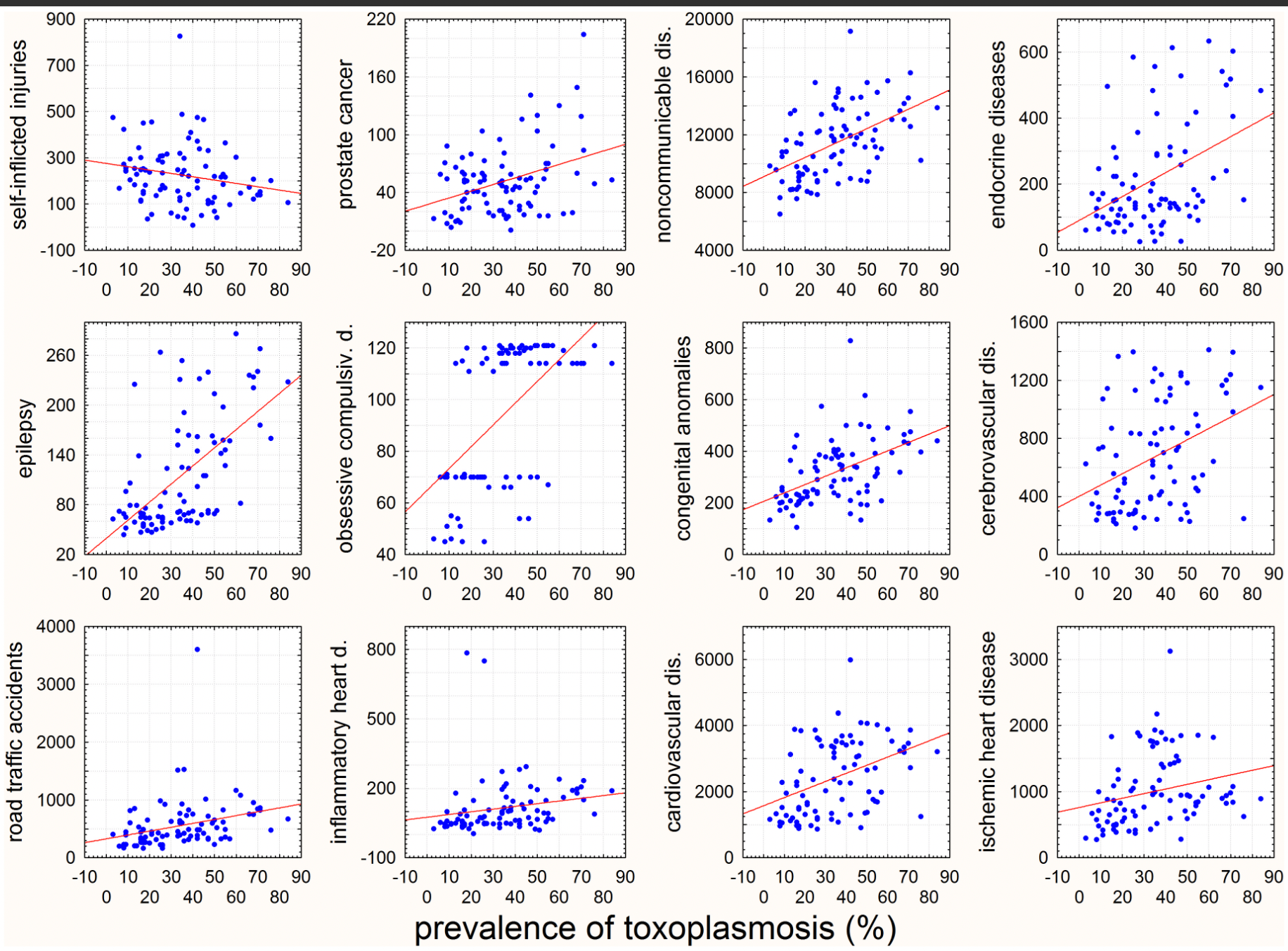
Okay, I know, correlation does not equal causation. However, can we all agree that we should look more into Toxoplasmosis?!
What to do?!
Why aren't we tackling pathogens like Toxoplasma with the same gumption that we tackled COVID-19? Firstly, it's probably simply too endemic for people to care. Pathogens such as Toxoplasma, Herpes and Epstein-Barr have become part of our normal way of life. Unless you have cold sores, genital herpes or glandular fever, you may not even be aware that you carry Herpes simplex or EBV. As for Toxoplasmosis, you have no idea. Before today, you may not have even known about it. And if you want to test for it, a regular doctor will think you're insane. Tests are not easily accessible, and most Toxoplasmosis tests are for acute symptomatic infections. I've worked with a Doctor over the last few years to generate a blueprint of my pathogen exposure via antibody testing and have put considerable effort into reducing my HSV-1 (cold sore) viral load and much to my surprise, according to the few types of Toxoplasmosis IgG antibody tests that are available (and that I have repeated) I am supposedly not a carrier.
That doesn't make Toxoplasmosis any less scary. We are all only one slice of infected dry-cured ham away from having it permanently lodged in our brains.
Without knowing the mechanism of causation, the links between infectious pathogens like Toxoplasma gondii and later noncommunicable diseases are too vague, delayed, and complicated for most academic researchers to pursue. But we should be going after them. We should be doing so much more than what we are doing.
There are also specific issues with Toxoplasmosis research that have delayed the field. Remember, the definitive hosts of the pathogen are cats. However, testing on cats is a sensitive subject – so much so that, due to activist pressure, the world's leading toxoplasmosis lab in Maryland was forced to close in 2019. The lab opened in 1982 and operated on only $625,000 of funding a year (!).
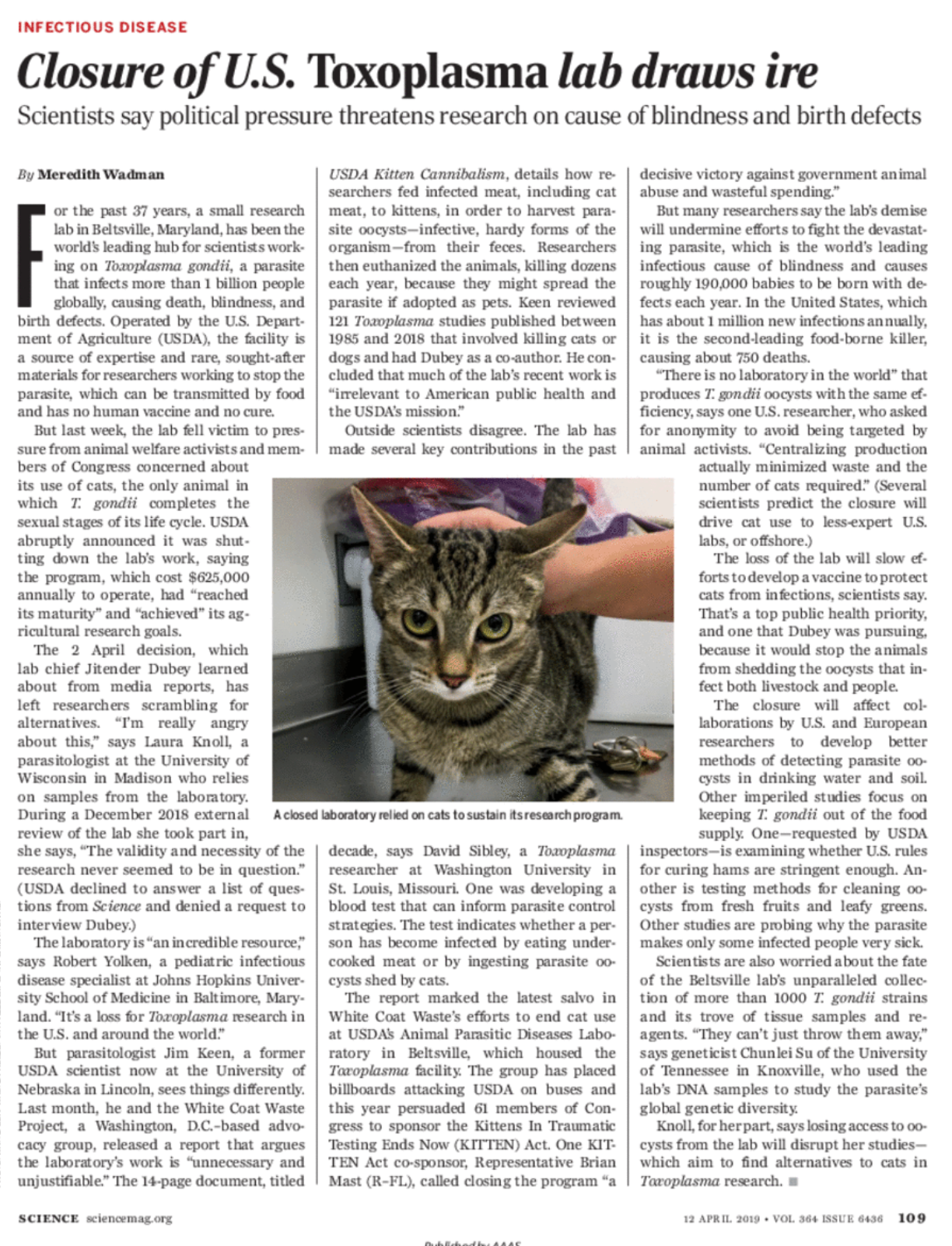
When I first started worrying about the lack of Toxoplasmosis research, I considered that a path forward might be using a foreign libertarian charter city to set up an experimental lab to restart testing on cats. In my opinion, the utility calculation of doing this massively outweighs the harm and loss of cats used in research. I write this as a staunch cat lover. However, the damage from Toxoplasmosis on humans appears to be very serious. I would take on the role of the hated leader of the foreign cat-killing research lab for the sake of future generations if needed.
That was until I found this paper.
The highlight of this research project was stumbling across a paper entitled Intestinal delta-6-desaturase activity determines host range for Toxoplasma sexual reproduction. As mentioned previously, cats are the only definitive hosts of Toxoplasmosis. The biological reasons behind this were largely unknown. That was until now. Here, the researchers noted that cats are the only mammals that lack delta-6-desaturase activity in their intestines. Delta-6-desaturase is an enzyme required for linoleic acid metabolism. It results in cats having systemic excess of linoleic acid. By inhibiting delta-6-desaturase in mice, and supplementing their diet with linoleic acid, Toxoplasma Gondii development happened in mice. Yes, by deactivating delta-6-desaturase and giving mice linoleic acid, you can, in the eye of Toxoplasma Gondii, TURN MICE INTO CATS.
I repeat: WE CAN TURN MICE INTO CATS.
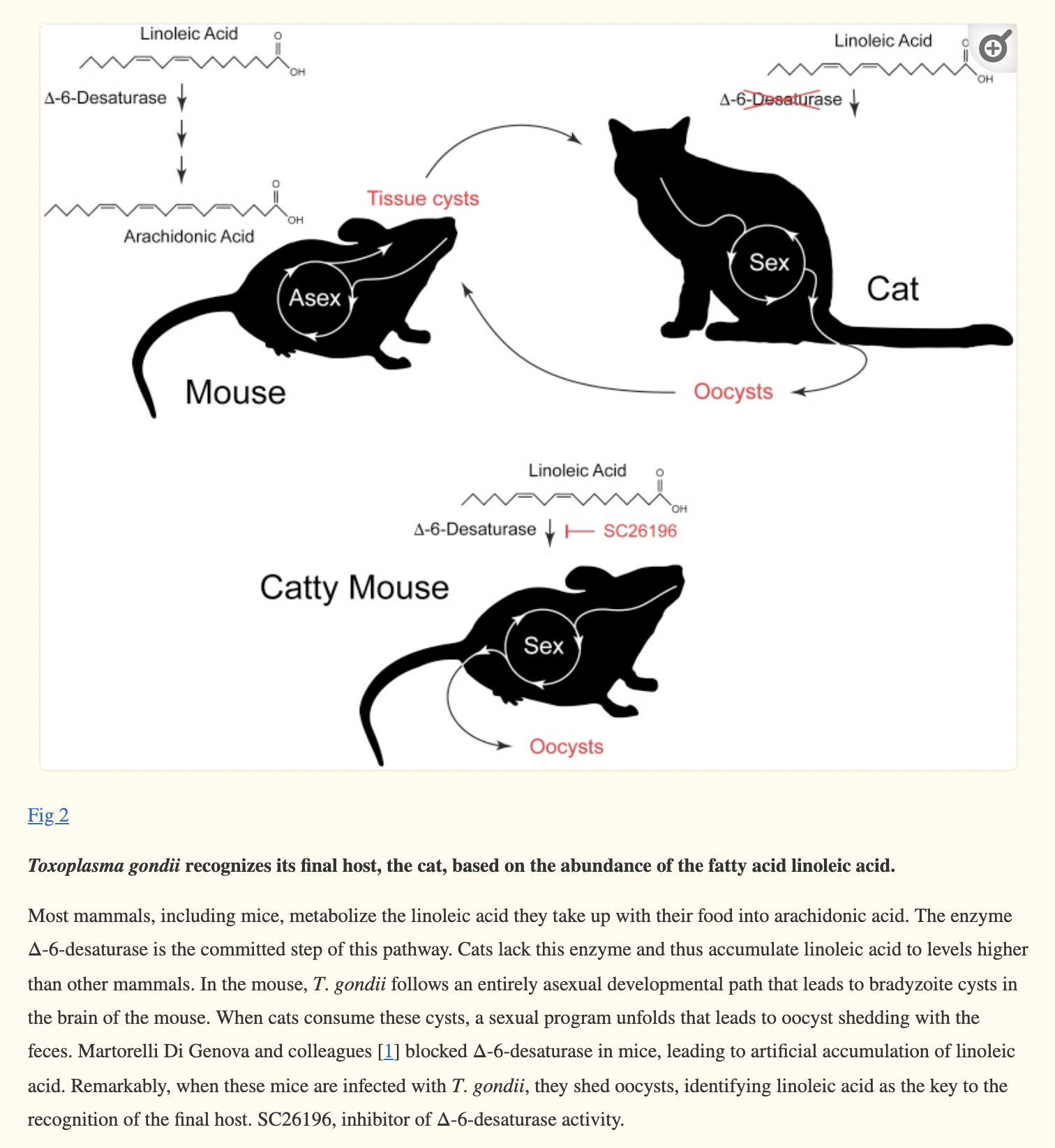
This species barrier alchemy is potentially huge for the field of Toxoplasmosis research. With this advance, cats’ lives can be spared, and Toxoplasmosis research can also become more cost-effective!! But first, we need to make people care enough and incentivize them to research it first! That is the purpose of this essay: to hopefully inspire more people to look into these topics.
Lastly, adequate vitamin D levels in the blood lessen almost all pathogen exposure harm, and it is estimated that ~40% of U.S. adults are deficient in it. Before you reach out for your Vitamin D pills, know that thanks to a statistical error, general recommendations for supplementing Vitamin D daily (600IU) are massively underestimated. Consult your doctor, but be aware of their limits and do your own research.
For a more in-depth look at infectious disease links to chronic illnesses, read the evolutionary biologist Paul W. Ewald's Plague Time: The New Germ Theory of Disease. This essay is dedicated to him. Let's take Paul's hypotheses more seriously before it is too late.
_____
Thanks to Mac Davis, Rob Rhinehart, Dr Rebecca Brachman and Olivia Allwood-Mollon for their guidance. All errors are mine alone.
